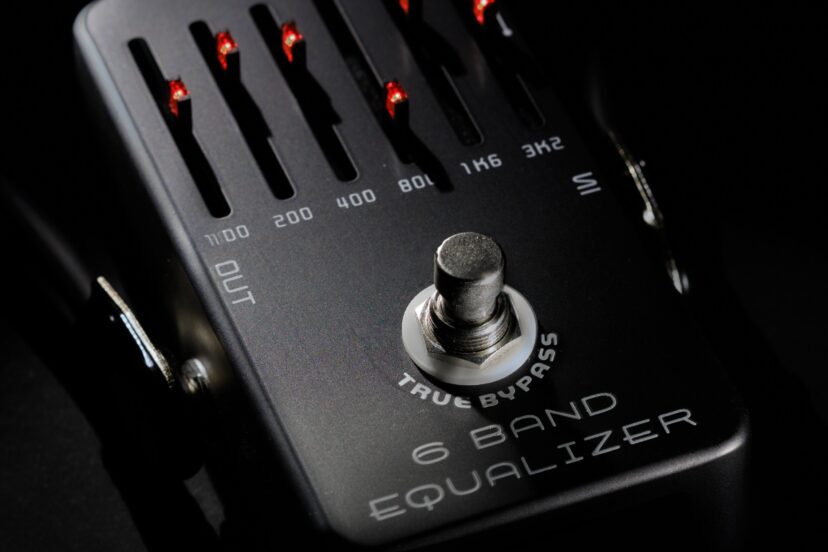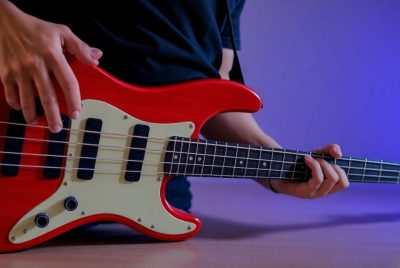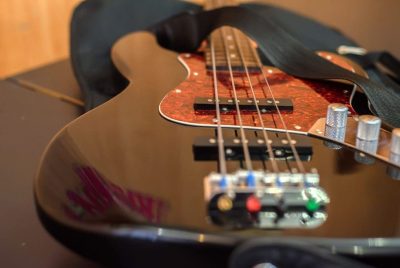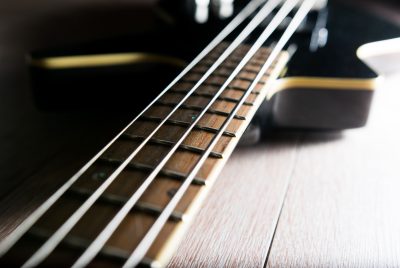Bass Pedal EQ: A Comprehensive Guide
A bass pedal EQ is an essential tool for every bassist, allowing us to shape our bass sound with precision. Let’s delve into its significance and workings.
Role of a Bass Pedal EQ
A Bass Pedal EQ, or Equalizer pedal, plays a crucial role in shaping the tonal character and sound quality of a bass guitar’s output. This versatile tool allows bassists to adjust specific frequency ranges of their sound, enabling them to highlight or diminish certain aspects of the tone to fit the context of the music they are playing.
The primary function of a Bass Pedal EQ is to provide precise control over the bass’s sonic palette. By boosting or cutting frequencies across the low, mid, and high ranges, players can achieve a wide variety of tones—from deep, thunderous lows that provide a solid foundation for a band’s sound, to punchy mids that cut through a mix for more presence, to crisp highs that add clarity and definition to the bass line.
Beyond tonal shaping, a Bass Pedal EQ can also serve as a problem-solving tool in live and studio settings. It can help mitigate issues such as feedback, room resonance, and instrument frequency clashes within a band. For instance, by cutting frequencies that are overly resonant in a particular venue, bassists can improve the overall sound quality of their performance.
Furthermore, an EQ pedal offers the ability to adapt the bass tone to different playing techniques (fingerstyle, slap, pick) and genres (jazz, rock, funk), providing bassists with the flexibility to seamlessly transition between diverse musical contexts. It also enhances the effectiveness of other pedals in the signal chain, such as overdrive or compression, by shaping the input signal to these effects for optimal results.
In essence, a Bass Pedal EQ is an indispensable tool for any bassist looking to exert greater control over their sound, offering the means to sculpt their tone with precision and creativity.
Anatomy of a Bass Pedal EQ
The anatomy of a Bass Pedal EQ (Equalizer) encompasses various components that together provide bassists with the capability to fine-tune their sound. Understanding each part can help users effectively manipulate their tone to suit different musical scenarios. Here’s a breakdown of the key elements typically found in a Bass Pedal EQ:
- Frequency Bands: Most Bass EQ pedals divide the audio spectrum into several bands or ranges. These bands are often tailored to the specific frequencies that affect the bass guitar’s sound, such as low (bass), midrange, and high (treble) frequencies. Each band has its own control knob or slider, allowing for adjustments (boost or cut) within that specific frequency range.
- Level or Gain Control: This control adjusts the overall output level of the pedal. Boosting the level can compensate for any volume loss when cutting frequencies, or it can provide a signal boost to the amp or next pedal in the chain.
- Sliders or Knobs: Depending on the design, an EQ pedal will use either sliders or knobs to control the boost or cut of the selected frequency bands. Sliders provide a visual representation of the EQ curve, while knobs may offer a more compact design.
- Bypass Switch: This footswitch allows the bassist to engage or disengage the EQ effect. When in bypass mode, the pedal does not affect the signal, allowing for an easy comparison between the EQ’d and unequaled sound.
- LED Indicator: An LED light typically indicates whether the pedal is active or in bypass mode, providing visual feedback on the pedal’s status.
- Input and Output Jacks: These are the points where the bass guitar connects to the pedal (input) and where the pedal connects to the amplifier or next effect pedal in the chain (output).
- Power Supply: EQ pedals can be powered by batteries or an external power supply. The choice of power source can affect the pedal’s performance and suitability for different playing situations.
- EQ Type: Some bass EQ pedals may also feature specific types such as graphic or parametric. Graphic EQs provide fixed frequency bands with control over the level of each band, while parametric EQs allow for adjustments to the frequency range and the width (Q) of each band, offering more precise control.
By manipulating these components, bassists can sculpt their sound by enhancing desired frequencies while reducing or eliminating unwanted ones, thereby achieving the perfect tone for any musical setting.
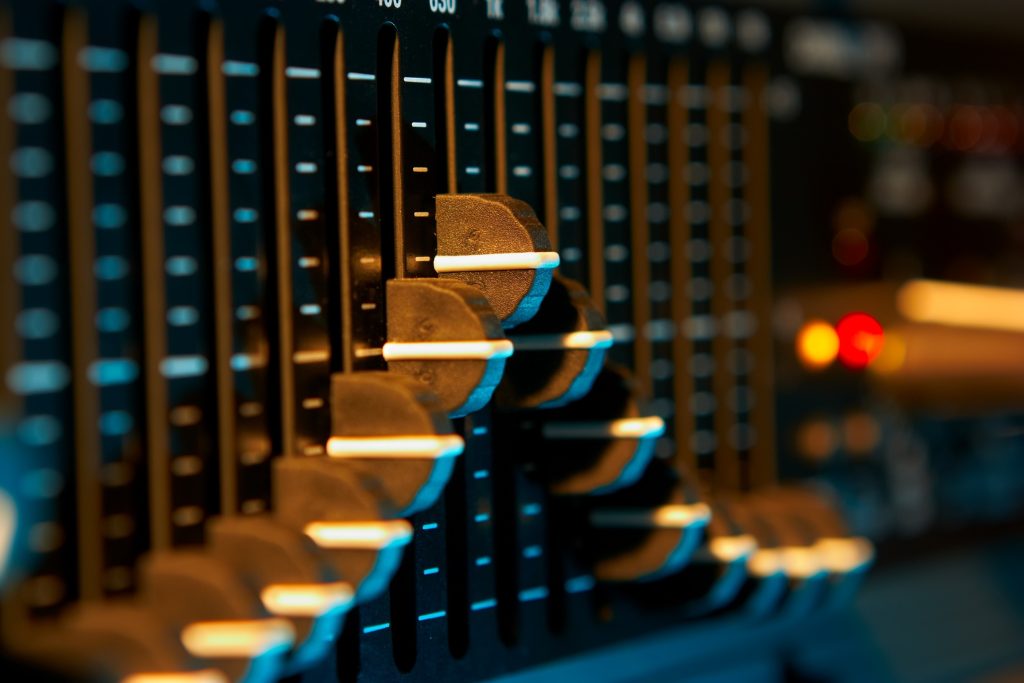
Decoding the Frequencies
Low Frequencies
These frequencies give your bass its depth and richness. If your sound feels thin or lacks body, try boosting the low frequencies.
Mid Frequencies
The mids are the ‘voice’ of your bass, contributing to its presence and warmth. Balancing the mids can help your bass cut through the mix without overpowering it.
High Frequencies
The highs add clarity and articulation to your bass sound. Too much can make your bass tone sound harsh, while too little might make it seem muffled.
The Art of EQ-ing
Establishing the Tone
When EQ-ing, start with all frequencies set flat, then adjust each band one at a time. Remember, EQ-ing is about enhancing the natural tone, not reinventing it.
Tweaking the Frequencies
Try subtle changes first, as drastic shifts can create an unnatural sound. If something doesn’t sound right, don’t hesitate to reset and start again.
Avoiding Common EQ Mistakes
Avoid boosting all frequencies, as it can lead to a muddy sound. Also, don’t be afraid of cutting frequencies. Sometimes, less is more when it comes to EQ-ing.
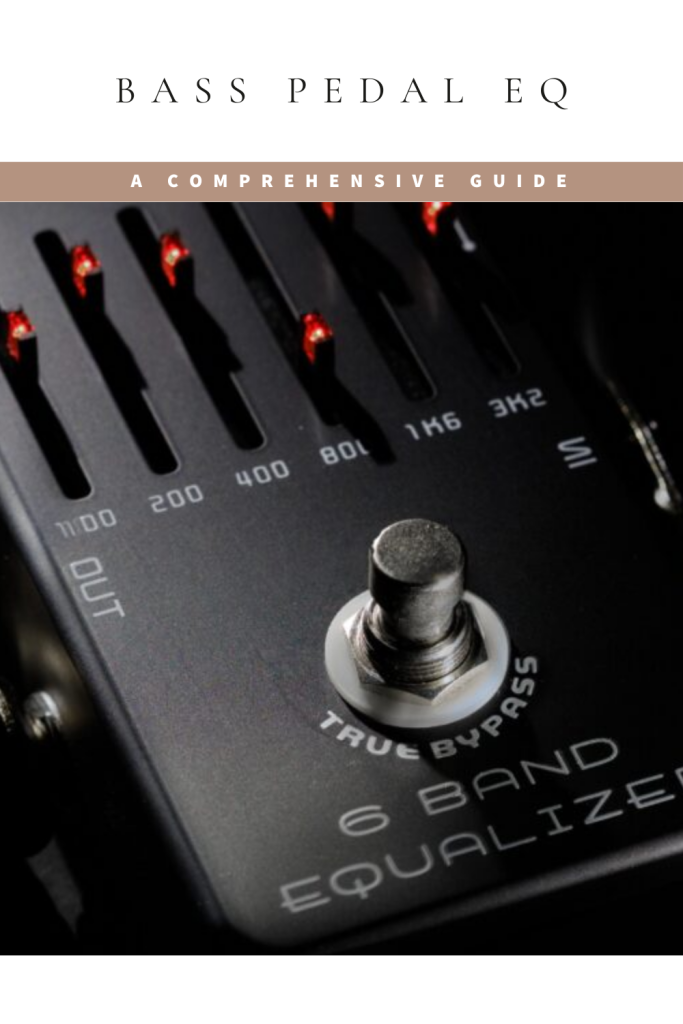
Choosing the Right Bass Pedal EQ
Types of Bass EQ Pedals
Bass EQ pedals come in various types, such as graphic EQs and parametric EQs, each offering different controls and flexibility.
Factors to Consider
When choosing an EQ pedal, consider its number of frequency bands, control flexibility, size, and of course, its sound quality and character.
My Top Picks for Bass Pedal EQs
Bass EQ pedals can be a vital tool in shaping your bass tone. By allowing you to boost or cut specific frequency ranges, they can help you cut through a mix, shape your tone to match your playing style, or adjust for different room acoustics. Here are some top picks for bass EQ pedals:
- Boss GEB-7 Bass Equalizer: A 7-band EQ pedal that provides a range of +/- 15dB, this pedal allows for precise tone shaping across the frequency spectrum.
- MXR M108S Ten Band EQ: This pedal gives you control over ten different frequency bands. It includes gain and volume sliders and has a robust build quality.
- Source Audio SA170 Programmable EQ: A digital EQ with 4 savable presets, it provides 8 frequency bands and offers the flexibility to customize your sound for different situations.
- Empress ParaEQ with Boost: This pedal offers a highly precise parametric EQ with the added functionality of a clean boost, making it highly versatile.
- Aguilar Tone Hammer Preamp/Direct Box: While not just an EQ pedal, the Aguilar Tone Hammer offers a powerful 3-band EQ with sweepable mids and an “Aguilar” drive circuit that adds subtle distortion.
- Tech 21 SansAmp Bass Driver DI: A preamp with a built-in EQ, it also offers drive for shaping your tone even further.
- MXR M82 Bass Envelope Filter: While technically a filter pedal, it’s used like an EQ to shape tone in a dynamic, performance-based context.
- Darkglass Microtubes B7K Ultra V2: This pedal is both an overdrive and a comprehensive EQ, providing a lot of tone-shaping power in one package.
- EHX Bass Big Muff Pi: This is a bass distortion/fuzz pedal that also includes a rudimentary EQ for added tone shaping.
- Tech 21 Q/Strip EQ and Preamp Pedal: This pedal emulates the EQ and filter section of a vintage console, providing a musical and warm tone.
Remember, when choosing an EQ pedal, it’s important to consider what frequencies you most want to control, how many bands of EQ you desire, and whether you want any extra features such as additional overdrive or the ability to save presets.
Conclusion
A bass pedal EQ is more than just a tool; it’s your secret weapon to a powerful, balanced, and distinctive tone. By understanding and mastering it, you can truly make your bass voice shine.
Frequently Asked Questions
- Why do I need a Bass Pedal EQ?
A Bass EQ allows you to shape your bass tone precisely, helping it to fit perfectly in any mix. It provides you with the ability to enhance certain frequencies and attenuate others, depending on the requirements of the song or performance. - What’s the difference between a Graphic EQ and a Parametric EQ?
A Graphic EQ provides control over fixed frequency bands, allowing you to cut or boost those frequencies. A Parametric EQ, on the other hand, offers more flexibility as you can choose the specific frequency, the amount of cut or boost, and the range of frequencies affected. - Can I use my Bass Pedal EQ as a boost pedal?
Yes, you can use your Bass Pedal EQ as a boost pedal. By raising certain frequencies, you can make your bass stand out during solos or specific parts of a song. - What frequencies should I boost for a heavier bass sound?
If you’re aiming for a heavier bass sound, try boosting the low frequencies. However, be cautious not to overdo it as too much low end can make your tone sound muddy. - I can’t seem to get the right tone even with an EQ pedal. What am I doing wrong?
EQ-ing is a nuanced art that takes practice. Try making subtle changes and focus on one frequency band at a time. If something sounds off, reset to a flat EQ and start again. Also, remember that the EQ pedal is just one part of your signal chain – the bass, amp, and other effects also contribute to your overall tone.

